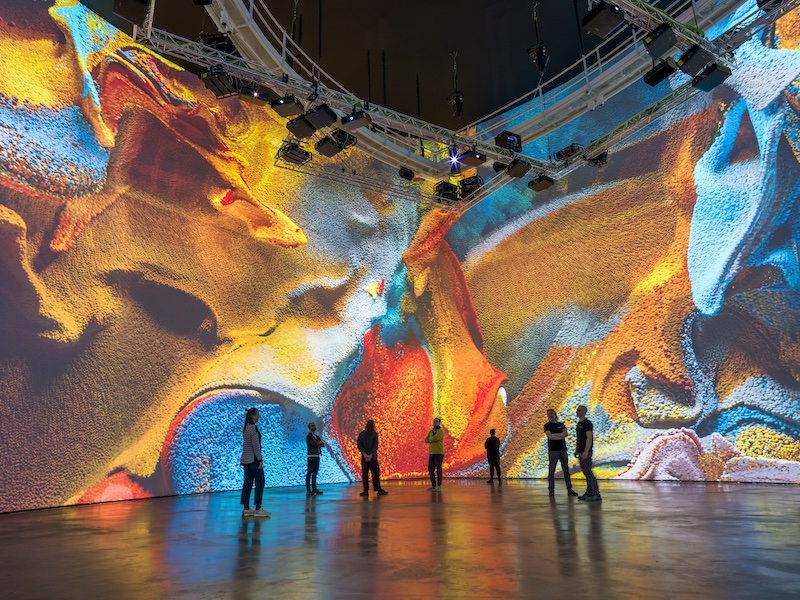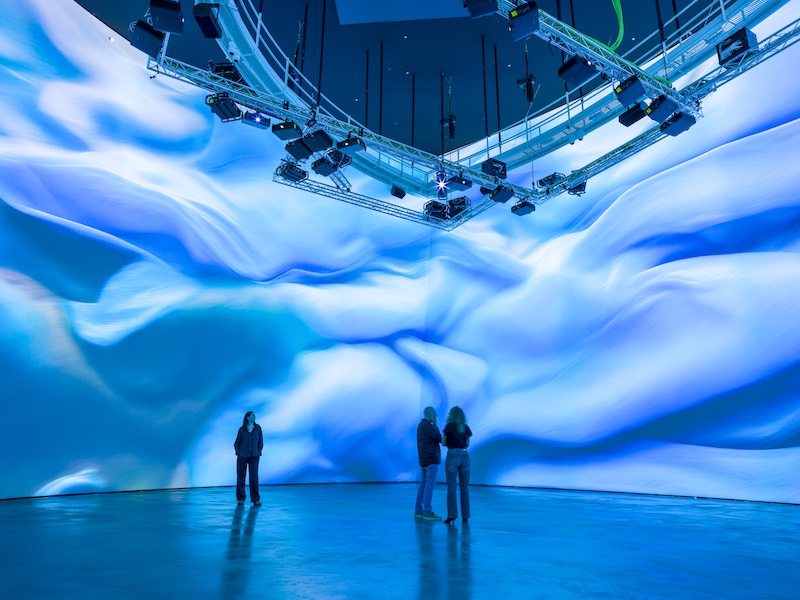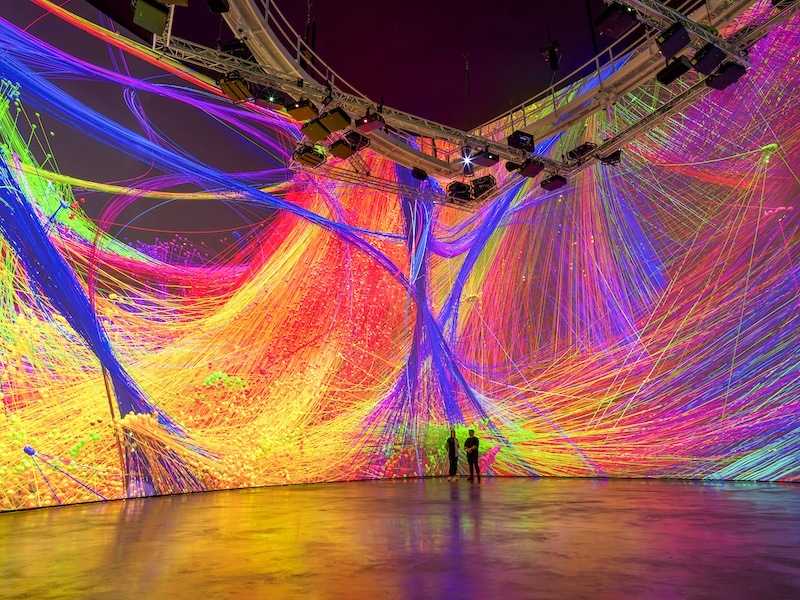by Jayne Wilkinson // Mar. 27, 2025
This article is part of our feature topic Public.
The building of all empires requires art and, much like the global franchise that is the Guggenheim, Refik Anadol’s generative AI artworks arrive alongside a new form of empire. His popular, immersive installations use machine learning models to train AI image projections that continually reshape themselves in unpredictable ways, making for wondrous, spectacle-type encounters. Critical as one might be in approaching the work—especially as it’s been recently popularized through major museum exhibitions—it’s difficult not to feel moved by a soaring sense of awe, immersed in an atmospheric digital fantasy-scape and strangely destabilized by minutes (or hours) lost in a kind of techno-reverie.

Refik Anadol Studio: ‘Living Architecture: Gehry,’ 2025, installation view at the Guggenheim Museum Bilbao // © Refik Anadol, Bilbao
For the past several years, Anadol has produced machine-generated artworks using largely similar methods drawn from source data related to nature, climate change, modern art and, now at the Guggenheim Bilbao, architecture and public space. Anadol’s installation, ‘Living Architecture: Gehry,’ uses open-access imagery and archival material from Frank Gehry’s various architectural projects, including the Bilbao museum, and features six chapters that move through different types of generated imagery: swooping, curvilinear forms, swirling colorful clouds, blues that could be deep space or deep water, as well as many variations on fast-moving image grids and in situ formations of Gehry-esque fantasy architecture.
Anadol is explicit that his work uses “ethical AI,” which he defines based on his processes, about which he is remarkably transparent. Unlike consumer AI image generators, the models he develops are trained on data sets that are either open source, that he owns (images from his digital archives) or that he has acquired the rights to (in this case, from the architect’s archives held by the Getty Institute in LA). The Guggenheim presentation contains a separate room that outlines this in visual detail, through renderings and videos. Anadol is committed to protecting other artists’ copyrights and refuses to use consumer AI products. He’s also concerned with the energy impact of artificial intelligence: part of the work is hosted by Google Cloud (a partner) on a sustainable server in the Netherlands and Anadol states that the exhibition uses only the equivalent of the amount of energy required to charge four smartphones over the course of a year.

Refik Anadol Studio: ‘Living Architecture: Gehry,’ 2025, installation view at the Guggenheim Museum Bilbao // © Refik Anadol, Bilbao
Given the demands of most contemporary media installations, this is impressive—but process alone can’t determine an ethical standard for generative art. Art is a powerful tool of persuasion, even if the message is aesthetically coded, and what is made public bears the politics of its making, regardless of intent: art is political as an act unto itself. We can critique how something was made, who funded it and who presented it, as is commonly done with artists who make work “about” a topic of public concern—like climate change (as Anadol has), multi-species realities or extraction—but who fail to consider the carbon footprint of their processes, the toxicity of their materials, or the impact of their funders. Such an approach, while useful, only answers half the question.
Immersive experiences are not without precedent in modern and contemporary art. Well before VR and AI, since at least the ’60s (arguably longer, if one considers architecture itself as a form of immersive art) artists have sought to disconnect gallery goers from external realities. At Bilbao, iconic artworks by Yayoi Kusama and Richard Serra are displayed in adjacent galleries and it’s difficult not to make comparisons with these titans of the 20th century. But where these artists produced immersive environments to foster a deeper understanding of human consciousness and the inner psyche (Kusama) or to make rigorous critiques of movement, perception and the politics of public space (Serra), the immersive qualities of Anadol’s work don’t produce lasting engagements. Although they are discussed as thought-provoking or inspiring, there is little that lingers beyond the experience.
Conceptually, a contemporary artwork addressing architecture, spatial design and archives is an opportunity not to dream but to critically probe how ideas of public space will be defined in the decades to come, as artificial intelligence is already radically reshaping the public sphere. Instead, the fluid, sci-fi distortions of Frank Gehry’s buildings and sketches produce an extremely polished environment that leaves little for interpretation—other than a lingering unease at how the tech industry is leveraging artists to make their technologies more palatable to the public. The CEO of the exhibition’s technology partner, telecom company Euskaltel, was on-stage at the press conference promoting 5G connectivity in the Basque region, while Ryan Zurrer, an NFT collector, digital art patron and early supporter of Anadol’s work, was also present, speaking passionately about the ways that art can be used to demystify AI so to make the public less fearful of it.

Refik Anadol Studio: ‘Living Architecture: Gehry,’ 2025, installation view at the Guggenheim Museum Bilbao // © Refik Anadol, Bilbao
Fearful or not, one of the riskiest things artists working with AI can do is use it uncritically, making it seem optimistic and fun for a public who is (or should be) questioning its widespread consumer applications. An ethics of AI in art should consider not only production (let’s assume that not stealing other artists’ work and not creating exhibitions that consume and pollute excessively is the baseline, not an ethical achievement) but also its interpretation. Anadol’s work is often described in terms related to fantasy—atmospheric, hallucinatory, imaginative, thought-provoking, dream-like—and while all those descriptors hold, that’s a dangerous way to treat both technological advancements and historical data.
In the United States of the present, archives, libraries and museums are being decimated by a dictatorial president and regime that will leave little for arts and science researchers not directly monetized by tech companies. What will happen to future archives, digital or otherwise, without the public infrastructure to maintain them? It’s not a stretch to suggest that public assets may well be governed by corporate artificial intelligence in the future. Archives themselves are already ideologically subject (as we know vis-a-vis Foucault) and the current events of one generation produce the history of the next. Using publicly accessible data as source material for art brings responsibilities that demand a more rigorous conceptual approach to their use—otherwise, there is little to distinguish technologically wondrous art from branded content or immersive advertising.

Refik Anadol Studio: ‘Living Architecture: Gehry,’ 2025, installation view at the Guggenheim Museum Bilbao // © Refik Anadol, Bilbao
Anadol will open Dataland, “the world’s first Museum of AI Arts,” in Los Angeles later this year, under the guise of open accessibility, although it currently requires a paid subscription model to access Dataland and Anadol’s ‘Living Encyclopedia.’ In a city reeling from massive wildfires, where disparities of wealth and poverty are beyond extreme, what is considered accessible is deeply divided along lines of class and income. The optimism of the contemporary tech spectacle is not mirrored by the realities of most, and this type of false futurism is deeply unsettling. An ethical approach to AI in art must engage with public materials through a more careful consideration of what we hold in common, and of what shared cultural heritage means in light of new technologies. Ethical or not, it is a dangerous proposition to make art that supports the goals and desires of the billionaire class and its growing tech empire, even more so under the guise of beautiful escapism.
Exhibition Info
Guggenheim Bilbao
Refik Anadol: ‘in situ’
Exhibition: Mar. 7-Oct. 19, 2025
guggenheim-bilbao.eus
Abandoibarra Etorb., 2, Abando, 48009 Bilbao, Bizkaia, Spain, click here for map





















